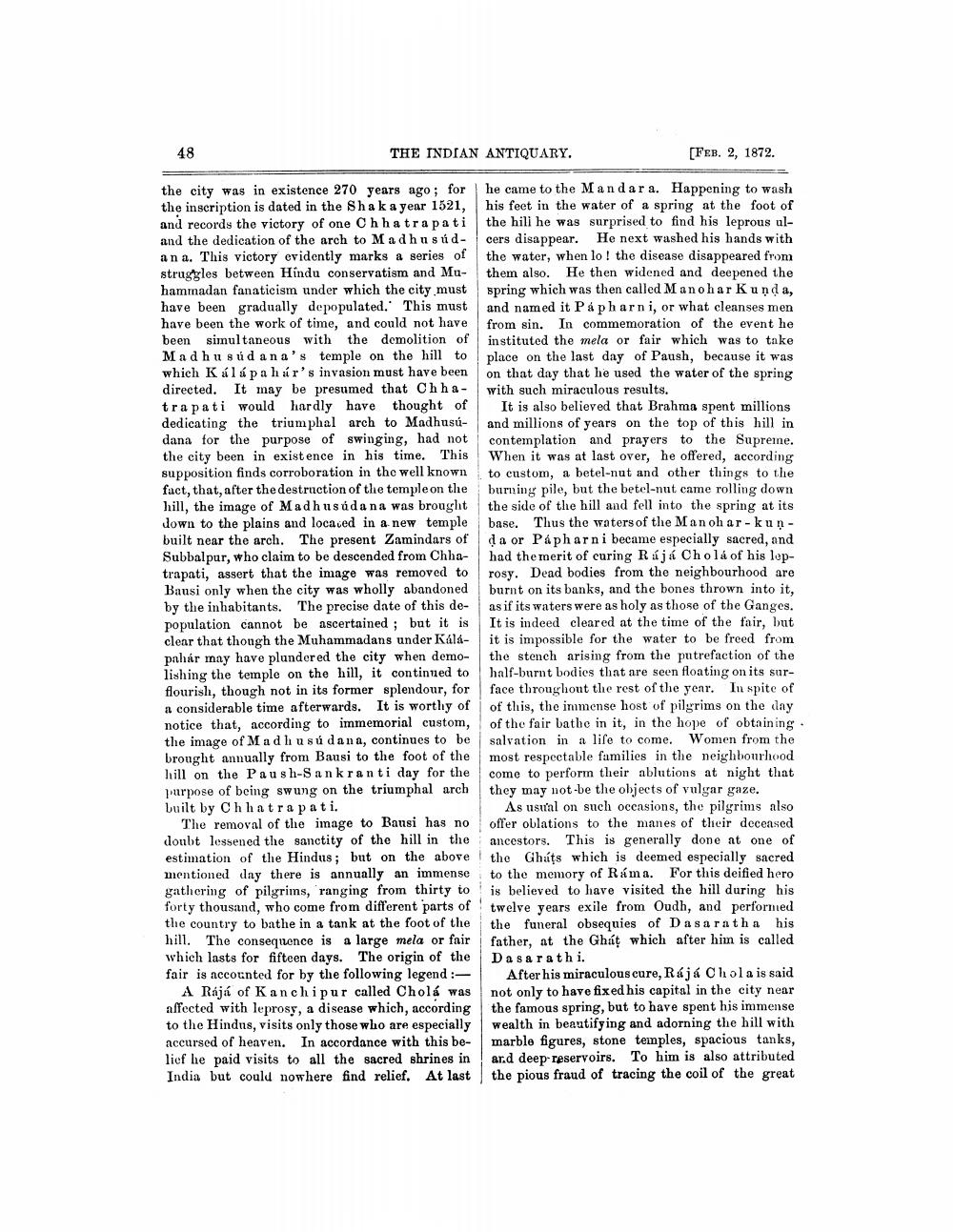________________
48
THE INDIAN ANTIQUARY.
[FEB. 2, 1872.
the city was in existence 270 years ago; for he came to the Mandara. Happening to wash the inscription is dated in the Shak a year 1521, his feet in the water of a spring at the foot of and records the victory of one Chhatrapati the hili he was surprised to find his leprous uland the dedication of the arch to Madhusud- cers disappear. He next washed his hands with ana. This victory evidently marks a series of the water, when lo ! the disease disappeared from struggles between Hindu conservatism and Mu- them also. He then widened and deepened the hammadan fanaticism under which the city must spring which was then called Manohar Kunda, have been gradually depopulated. This must and named it Pá pharni, or what cleanses men have been the work of time, and could not have from sin. In commemoration of the event he been simultaneous with the demolition of instituted the mela or fair which was to take Madhusudana's temple on the hill to place on the last day of Paush, because it was which Kálápa hár's invasion must have been on that day that he used the water of the spring directed. It may be presumed that Chha- with such miraculous results. trapati would hardly have thought of It is also believed that Brahma spent millions dedicating the triumphal arch to Madhusú- and millions of years on the top of this hill in dana for the purpose of swinging, had not contemplation and prayers to the Supremne. the city been in existence in his time. This When it was at last over, he offered, according supposition finds corroboration in the well known to custom, a betel-nut and other things to the fact, that, after the destruction of the temple on the burning pile, but the betel-nut came rolling down hill, the image of Madhusuda na was brought the side of the hill and fell into the spring at its down to the plains and locaved in a new temple base. Thus the waters of the Manohar-kunbuilt near the arch. The present Zamindars of da or Pápharni became especially sacred, and Subbalpur, who claim to be descended from Chha- had the merit of curing Raja Cholá of his leptrapati, assert that the image was removed to rosy. Dead bodies from the neighbourhood are Bausi only when the city was wholly abandoned burnt on its banks, and the bones thrown into it, by the inhabitants. The precise date of this de- as if its waters were as holy as those of the Ganges. population cannot be ascertained ; but it is It is indeed cleared at the time of the fair, but clear that though the Muhammadans under Kálá- it is impossible for the water to be freed from pnhár may have plundered the city when demo- the stench arising from the putrefaction of the lishing the temple on the hill, it continued to half-burnt bodies that are seen floating on its surflourish, though not in its former splendour, for face throughout the rest of the year. In spite of a considerable time afterwards. It is worthy of of this, the immense host of pilgrims on the day notice that, according to immemorial custom, of the fair bathe in it, in the hope of obtaining. the image of Madlusú dana, continues to be salvation in a life to come. Women from the brought annually from Bausi to the foot of the most respectable families in the neighbourhood lill on the Pau sh-Sankranti day for the come to perform their ablutions at night that purpose of being swung on the triumphal arch they may not be the objects of vulgar gaze. built by Chhatrapati.
As usual on such occasions, the pilgrims also The removal of the image to Bausi has no offer oblations to the manes of their deceased doubt lessened the sanctity of the hill in the ancestors. This is generally done at one of estimation of the Hindus; but on the above the Gháts which is deemed especially sacred mentioned day there is annually an immense to the memory of Ráma. For this deified hero gathering of pilgrims, ranging from thirty to is believed to have visited the hill during his forty thousand, who come from different parts of twelve years exile from Oudh, and performed the country to bathe in a tank at the foot of the the funeral obsequies of Dasaratha his hill. The consequence is a large mela or fair father, at the Ghát which after him is called which lasts for fifteen days. The origin of the Dasarathi. fair is accounted for by the following legend :- After his miraculous cure, Rája Chola is said
A Rájá of Kanchipur called Cholá was not only to have fixed his capital in the city near affected with leprosy, a disease which, according the famous spring, but to have spent his immense to the Hindus, visits only those who are especially wealth in beautifying and adorning the hill with accursed of heaven. In accordance with this be- marble figures, stone temples, spacious tanks, lief he paid visits to all the sacred shrines in and deep-reservoirs. To him is also attributed India but could nowhere find relief. At last the pious fraud of tracing the coil of the great




